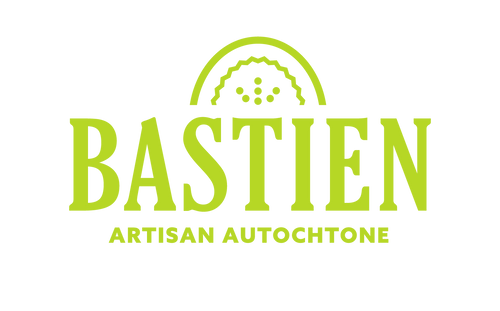Kwe!
At Bastien, we make our moccasins in a traditional and sustainable way. What does that mean? It means that we apply traditional techniques that have been adapted, but above all we pay a lot of attention to the origin of our raw materials.
Traditionally in the spirit of sustainability, during hunting time, all parts of the animal were used for food or to also make various objects: flesh, bones, organs and, of course, the hide that was used to make clothes and moccasins, amongst others.
In respect to keeping products sustainable in the Bastien manufacturing process, we know the origin of our raw materials and specifically the leather that we use.
Hides from hunting and the food sector
Bastien products are made of moose and cow hide. To obtain the hides, we rely on the Tannery des Ruisseaux located in Saint-Pascal de Kamouraska, Quebec. They produce leathers that only come from the food industry. This means the animals are not raised or hunted for their fur or skin, they are raised or hunted for food.
These hides are obtained in this way are skins that would be thrown away if no one was there to collect them. So that's exactly what we do: we repurpose the hide to use as much of the animal's parts as possible.
The hides that we acquire prevents waste. As Indigenous People and the sustainable understanding that we have, we respect and reuse everything an animal gives us.
Moose hides from hunting season
For moose hides, the tannery collects hides that come from hunting species only. Where do they get these hides from? The tannery has agreements with local butcher and with people who process moose meat. ides are recovered in a territory that goes from Quebec City to the Gaspé Peninsula as well as in Nova Scotia and New Brunswick.

To assist the tannery with this task, agents are assigned throughout the territory where the hides are collected. These agents first deliver salt to the butcher facility to preserve the hides. As soon as the skin is removed from the animal, the butchers have to put it in a large quantity of salt to preserve it. When the butcher shops have several hides in stock, the tannery will pick them up by a truck and transports them back to a workshop where they will soon be transformed into leather.
When preserving the hides, there is represents additional work for participating butcher shops, but the tannery provides the salt and also pays for each individual hide. This is a great way for the butcher shops to avoid unnecessary waste of a hide that can be used to make products like moccasins and many other things.
Rather than sending their moose to a butcher for processing, many hunters have their moose meat cut up or processed by someone they know who can do this. Some of these people then bring the hide from their hunt to the tannery. However, not everyone does this as it can be quite time consuming to preserve the hide and to transport it to the butcher. , Are you a moose hunter that would like to avoid throwing away the hide? If you would like to do this (and feel comfortable), apply salt to the hide as soon as you remove it. Then transport the hide to Saint-Pascal de Kamouraska. Contact the Tannery des Ruisseaux to learn more about this process and how you can contribute to being a more sustainable hunter than you already are.
Cow hides from the food sector
For cow (and beef) hides, the tannery sources these from local slaughterhouses. Some of these hides come from dairy cows, but most come from cattle raised for meat. The hides from these cattle are often thicker and of better quality to produce leather, as the animals live outside year round.
As for moose hides, the tannery will harvest them on a regular basis. Again, selecting hides that come from the food supply helps to respect sustainable values that Indigenous People have and to give a second life to skins or hides that would be thrown away our buried.
A responsible and sustainable tanning process
When the hides arrive at the tannery, they start a twenty step process. Some of these steps may differ depending on the type of hide and the intended use of the hides.
At the Tannery des Ruisseaux, hides are chrome tanned with a formula that was established in 1969 that has been improved over the years. . The formula changes depending on the type of hide and type of leather desired.

In thier formula, the tannery uses water-based and vegetable sourced tannins made from chestnut, mimosa and quebracho tree bark. They have chosen to use products that are the least harmful to the environment and have aligned with the Canadian requirements that ban dangerous substances and goods.
In addition to being environmentally friendly throughout the tanning process, the tannery also minimizes their use of water throughout the remainder of the process. They reuse some of the water used to tan the leather from the cooling systems on the machines. The second half to this is that they recycle the used water in an onsite treatment process and then return the water to the City of St-Pascal's wastewater treatment system for final purification.
Suede from the United States
For the suede, due to the quantity and quality required, we source it from the United States. This was the closest option for us with the quantity and quality of leather we required for the manufacturing. We were careful to choose a tannery that aligned with the vision that we had as a company but also as Indigenous People.
We are proud to partner with a family owned tannery that has been in business since 1936. From the very beginning, they started their activities in a sustainable way with the idea of recycling "waste" from local tanneries to make leather gloves. Thegloves. The tannery has since expanded its activities and now produces leather.
In addition, the tannery follows all of the environmental regulations as well as the US labor standards. They work to minimize their water consumption, treating it directly after use in their own water treatment plant. From a company standpoint, they also offer their employees decent wages and good working conditions, as well as a safe work environment. Their leather and their values as a company align with Bastien Industries values.
Leather and moccasins made of authenticity
Wecarefully select leathers that fit the Bastien vision and aligns with the heritage, authenticity, values and traditions that they carry with them. We offer quality products that are comfortable to wear and that reflect not only us as a company but also our community.
To see how we produce our authentic Indigenous moccasins with passion, please read our 8 steps to crafting a Bastien moccasin by hand.
Tiawenhk, entïio' chia' önenh!
Wendat words of the day





